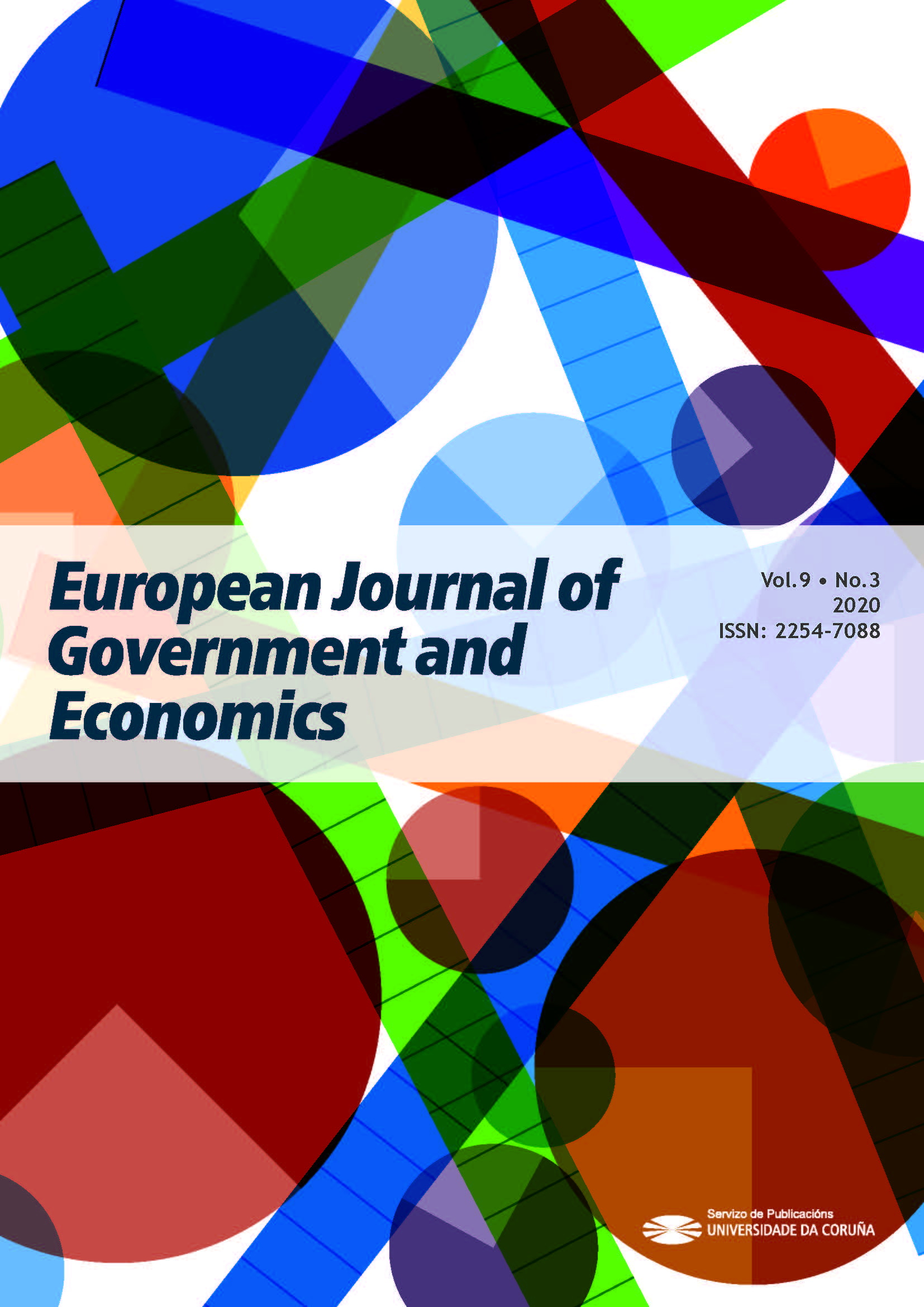Government balance-consistent economic growth rates and their implications: A study of the euro area countries
Main Article Content
Abstract
Using the model derived by Bajo-Rubio (2014), this paper estimates government budget balance-consistent growth rates for the euro area countries. A comparison of these estimates to their actual growth rates indicates that most of these countries are growing at rates that are very similar to their government balance-consistent growth rates. This finding implies that many euro area countries would not be experiencing excessive imbalances in their government budget over the long-run that could harm future economic growth. The analysis has also shown that for many euro area countries, the predictions of the model seem to be broadly consistent with their actual fiscal experience.
Keywords:
Downloads
Article Details
References
Adam, C.S. and Bevan, D.L. (2005). Fiscal deficits and growth in developing countries. Journal of Public Economics, 89, 571-597. https://doi.org/10.1016/j.jpubeco.2004.02.006
Ahmad, A.H. and Aworinde, O.B. (2019). Are fiscal deficits inflationary in African countries? A new evidence from an asymmetric cointegration analysis. North American Journal of Economics and Finance, 50. https://doi.org/10.1016/j.najef.2019.100999
Bajo-Rubio, O. (2014). Balance-constrained growth rates: generalizing Thirlwall’s law. Applied Economics Letters, 21(9), 593-596. https://doi.org/10.1080/13504851.2013.877563
Belinga, V., Benedek, D., de Mooij, R. and Norregaard, J. (2014). Tax Buoyancy in OECD Countries. International Monetary Fund, IMF Working Paper WP/14/110. https://doi.org/10.5089/9781498305075.001
Boschi, M. and d’Addona, S. (2017). The stability of tax elasticities over the business cycle in European countries. Australian National University, CAMA Working Paper 44/2017. https://doi.org/10.2139/ssrn.2967524
Brady, G. L. and Magazzino, C. (2018a). Fiscal sustainability in the EU, Atlantic Economic Journal, 46(3), 297-311, doi:10.1007/s11293-018-9588-4. https://doi.org/10.1007/s11293-018-9588-4
Brady, G. L. and Magazzino, C. (2018b). Government debt in EMU countries, The Journal of Economic Asymmetries, 18. https://doi.org/10.1016/j.jeca.2018.e00096
Bussière, M., Ferrara, L., Juillard, M. and Siena, D. (2017). Can fiscal budget-neutral reforms stimulate growth? Model-based results. Banque de France Working Paper No. 625. https://doi.org/10.2139/ssrn.2955120
Castro, V. (2011). The impact of the European Union fiscal rules on economic growth. Journal of Macroeconomics, 33(2), 313-326. https://doi.org/10.1016/j.jmacro.2010.09.003
Catão, L.A.V. and Terrones, M.E. (2005). Fiscal deficits and inflation. Journal of Monetary Economics, 52(3), 529-554. https://doi.org/10.1016/j.jmoneco.2004.06.003
Cebula, R.J. (1995). The impact of federal budget deficits on economic growth in the United States: An empirical investigation, 1955-1992. International Review of Economics and Finance, 4(3), 245-252. https://doi.org/10.1016/1059-0560(95)90042-X
Cebula, R.J. (2018). Impact of US federal government budget deficits on the ex ante real interest rate yield on 10-year treasury notes during the post-Bretton Woods (1972-2016) era. Journal of Economics and Finance, 42, 828-835. https://doi.org/10.1007/s12197-017-9424-8
Deli, Y., Rodriguez, A. G., Kostarakos, I. and Varthalitis, P. (2018). Dynamic tax revenue buoyancy estimates for a panel of OECD countries. The Economic and Social Research Institute (ESRI) Dublin, ESRI Working Paper No. 592.
Dudine, P. and Jalles, J. T. (2018). How buoyant is the tax system? New evidence from a large heterogeneous panel. Journal of International Development, 30(6), 961-991. https://doi.org/10.1002/jid.3332
European Commission (2014). Report on Public Finances in EMU 2014. European Economy 9-2014. https://doi.org/10.2765/7626
Forte, F. and Magazzino, C. (2013). Twin deficits in European countries. International Advances in Economics Research, 19(3), 289-310, https://doi.org/10.1007/s11294-013-9406-3
Jalil, A., Tariq, R. and Bibi, N. (2014). Fiscal deficit and inflation: New evidences from Pakistan using a bounds testing approach. Economic Modelling, 37, 120-126. https://doi.org/10.1016/j.econmod.2013.10.029
Kameda, K. (2014). Budget deficits, government debt, and long-term interest rates in Japan. Journal of Japanese and International Economies, 32, 105-124. https://doi.org/10.1016/j.jjie.2014.02.001
Koester, G. and Priesmeier, C. (2017). Revenue elasticities in euro area countries. European Central Bank, ECB Working Paper 1989.
Lau, W-Y. and Yip, T-M. (2019). The nexus between fiscal deficits and economic growth in ASEAN. Journal of Southeast Asian Economies, 36(1), 25-36. https://doi.org/10.1355/ae36-1d
Laubach, T. (2009). New evidence on the interest rate effects of budget deficits and debt. Journal of the European Economic Association, 7(4), 858-885. https://doi.org/10.1162/JEEA.2009.7.4.858
Lin, H-Y. and Chu, H-P. (2013). Are fiscal deficits inflationary? Journal of International Money and Finance, 32, 214-233. https://doi.org/10.1016/j.jimonfin.2012.04.006
Ramey, V.A. (2019). Ten years after the financial crisis: What have we learned from the renaissance in fiscal research? Journal of Economic Perspectives, 33(2), 89-114. https://doi.org/10.1257/jep.33.2.89
Taylor, L., Proaño, C.R., de Carvalho, L. and Barbosa, N. (2012). Fiscal deficits, economic growth and government debt in the USA. Cambridge Journal of Economics, 36 (1), 189-204. https://doi.org/10.1093/cje/ber041
Thirlwall, A. P. (1979). The balance of payments constraint as an explanation of international growth rate differences. Banca Nazionale del Lavoro Quarterly Review, 32(128), 45-53, (republished in 2011 in PSL Quarterly Review, 64(259).
Thirlwall, A. P. (2011). Balance of payments constrained growth models: history and overview. PSL Quarterly Review, 64(259), 307-351.
Trachanas, E. and Katrakilidis, C. (2013). The dynamic linkages of fiscal and current account deficits: New evidence from five highly indebted European countries accounting for regime shifts and asymmetries. Economic Modelling, 31, 502-510. https://doi.org/10.1016/j.econmod.2012.12.026






